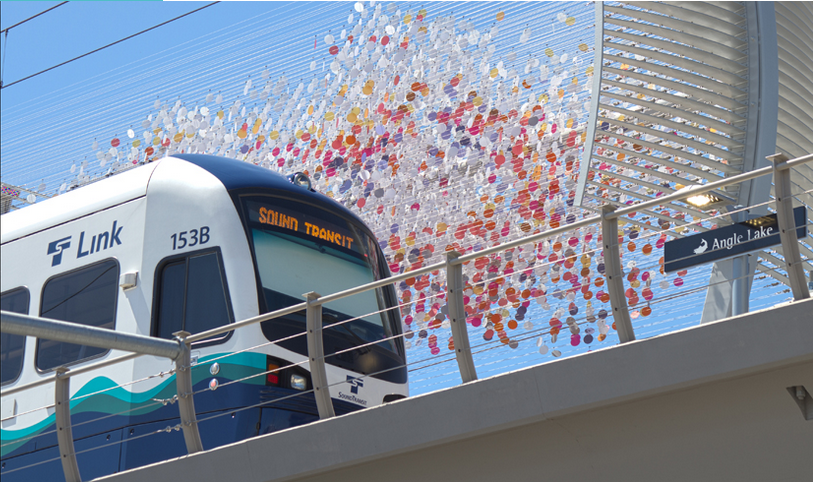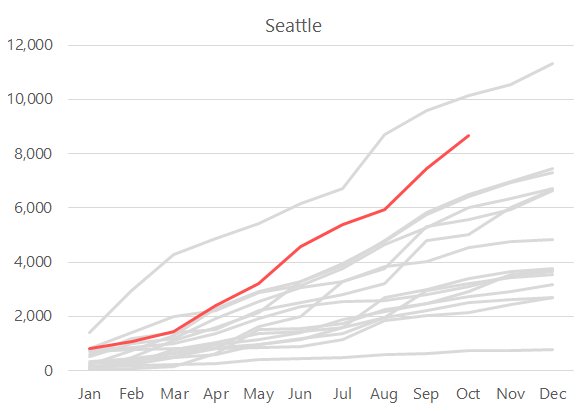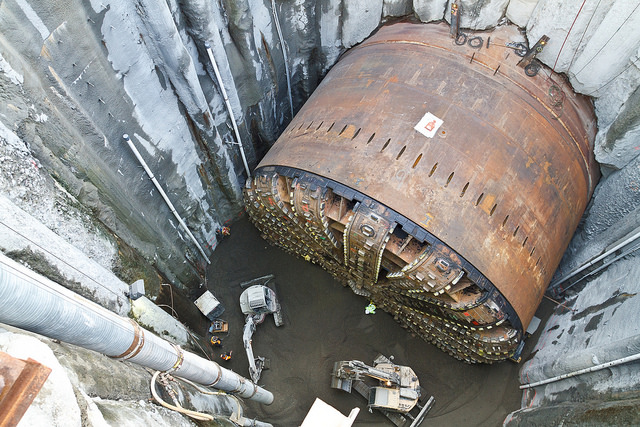
Author’s Note: So many big things happened in 2016, I neglected to mention the U Link extension, which brought light rail service to Capitol Hill and Husky Stadium in March. Too important of a story to miss considering how much it’s improved mobility to and from those areas!
Ignoring the national political scene for a moment, 2016 was a good year for Seattle. In August, we (resoundingly with 68% of the vote) doubled the housing levy, raising $290 million over seven years for affordable housing. In September, we lowered speed limits across the city to 25 mph on arterials and 20 mph on residential streets, and Sound Transit opened the Angle Lake station in SeaTac. In November we, with 54% of the vote, passed an ambitious Sound Transit 3 (ST3) transit package that will invest $54 billion over 25 years to add 62 new miles of light rail and 64 miles of bus rapid transit. We raised the minimum wage to $13 in Seattle, and voted to eventually do the same statewide. We led the nation in construction cranes allowing Seattle to build in the ballpark of 10,000 units of housing to lead the metro region and peer cities throughout the nation. So in sum, a talented crop of politicians were elected to office, many long-term investments were made, and plans were laid for Seattle to thrive and grow in a sustainable way.

Bertha Surges
The future of the SR-99 tunnel project was murky at this time last year. But the tunnel boring machine dubbed “Bertha” proved to be the little engine that could in 2016. The tunnel went from a mere 10% done last December to 73% bored today. Now, this doesn’t necessarily make the $4 billion tunnel a wise investment, especially when the Washington State Department of Transportation (WSDOT) went ahead and drew up a surface highway design for Alaskan Way to replace the viaduct–and here we thought humans not cars might rule this little strip of urban real estate–but it does mean the viaduct is closer to coming down. We can expect the Bertha tunnel boring to be completed in 2017 barring any further setbacks, which would just leave building the road deck to make it operational and allow us to begin tearing down the viaduct circa 2019.

Minimum Wage Climbs
On January 1st, Seattle’s hourly minimum wage will go up to $15 for large employers not paying medical benefits, up from its 2016 minimum of $13. Workers at large firms that pay medical benefits will have to wait until 2018 for $15, while those at small firms have even longer. But we’ll get there eventually, and the steady rise of the wage floor in Seattle seems to be lifting wages without harming businesses or costing employment since job growth was triple the national average and unemployment remained very low in the city.
The state of Washington wisely voted by a large margin (57.4 to 42.6 percent) to raise the state’s hourly minimum wage to $13.50. With its higher minimum wage, Seattle won’t see a direct benefit, but will indirectly benefit thanks to a lower wage differential with the surrounded suburbs, not to mention in rural Washington, which should discourage employers to leave for outlying areas in a race to the bottom scenario.
2016 Election
We recapped the 2016 state and local election results here. The urbanist highlight was that Sound Transit 3 ballot measure was passed with room to spare, setting in motion three decades worth of rapid transit investment. And transit improvements won’t just be on land, but also by sea as Kitsap County voted to add fast ferry service for humans (without cars) to commute between Downtown Seattle and Bremerton much more quickly. Travel times will be cut in half to about 30 minutes.
Senator Patty Murray and Governor Jay Inslee were reelected. Unfortunately for Democrats, winning the top of ticket didn’t translate into taking control of the state senate. Republicans managed to hold on in a few close suburban races, particularly the 28th district where Steve O’Ban weathered a strong challenge from Marisa Peloquin.
State senator Pramila Jayapal, who’s been a stalwart for immigrant rights, is headed to Washington, D.C. representing the 7th congressional district replacing retiring Representative Jim McDermott, who had represented Seattle in the House since 1989. To replace Jayapal, the King County Council voted to appoint Puget Sound Sage Executive Director Rebecca Saldaña. Another new face headed to Olympia is homeless advocate Nicole Macri, who we endorsed in the primary and general to represent the 43rd legislative district.
Year Ahead
While 2016 was a good year for Seattle, many challenges lie ahead. A good deal of political energy will be dedicated to passing the upzones that will initiate the inclusionary zoning program termed Mandatory Housing Affordability (MHA). The program will better harness Seattle’s rapid growth for social good in the form of affordable housing.
Meanwhile, local business publications have been hypothesizing ($) that the market will start cooling off in 2017, but they’ve been wrong before (for example, same time last year). Moreover, since analysts are predicting developers will act quickly to slow their building efforts, it’s hard to imagine the long predicted housing correction will be a big boon to low-income tenants. But I could be wrong!
The City will also likely be conducting an Environmental Impact Statement (EIS) to allow another Housing Affordability and Livability Agenda (HALA) recommendation to loosen restrictions on accessory dwelling units, more commonly called granny flats and backyard cottages. The EIS isn’t by choice but the result of the Queen Anne Community Council suing the City to force an EIS.
Mayor Ed Murray will seek reelection in 2017 and so far no serious challenger has emerged to run against him, and time is winding down to mount a serious challenge. It would appear all the task forces did the trick!
Councilmember Tim Burgess announced he will not run for reelection a few weeks after tenant advocate Jon Grant announced he was in. The now open seat will likely garner several more challengers. While Burgess’s Position 8 seat is a free-for-all, most expect Councilmember Lorena González to cruise to reelection in Position 9.
Seattle Greenways is dedicating their 2017 efforts to working to double the funding for Vision Zero to increase safety with better street designs. The influential organization, which helped push the City to lower speed limits in 2016, is also pushing to make the Move Seattle RapidRide+ corridors multi-modal corridors and to use tactical urbanism to promote livable and safe streets.
- District 1: Connect Georgetown to South Park.
- District 2: Extend the Rainier Ave Safety Corridor Project north and south.
- District 3: Make it easier and safer to walk and bike to and from the Capitol Hill light rail station.
- District 4: Safe and dignified crossings of I-5.
- District 5: Safe routes to transit stations from “coast to coast.”
- District 6: Make the 83rd and Greenwood intersection, the gateway to Greenwood, safe for families to cross.
- District 7: Safe east-west route between Uptown and South Lake Union.
And finally, bike advocates are hoping for more protected bike facilities, especially the kind that connect to each other. As Ryan Packer alluded to yesterday, the bike network progress has been slow.
Doug Trumm is publisher of The Urbanist. An Urbanist writer since 2015, he dreams of pedestrian streets, bus lanes, and a mass-timber building spree to end our housing crisis. He graduated from the Evans School of Public Policy and Governance at the University of Washington in 2019. He lives in Seattle's Fremont neighborhood and loves to explore the city by foot and by bike.

